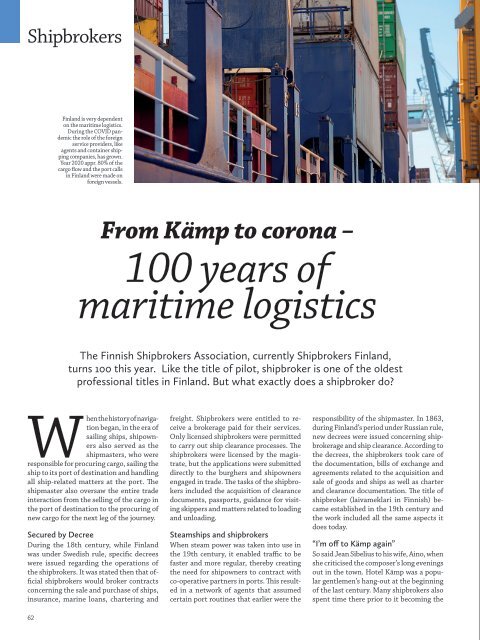Create successful ePaper yourself
Turn your PDF publications into a flip-book with our unique Google optimized e-Paper software.
Shipbrokers<br />
Finland is very dependent<br />
on the maritime logistics.<br />
During the COVID pandemic<br />
the role of the foreign<br />
service providers, like<br />
agents and container shipping<br />
companies, has grown.<br />
Year <strong>2020</strong> appr. 80% of the<br />
cargo flow and the port calls<br />
in Finland were made on<br />
foreign vessels.<br />
From Kämp to corona –<br />
100 years of<br />
maritime logistics<br />
The <strong>Finnish</strong> Shipbrokers Association, currently Shipbrokers Finland,<br />
turns 100 this year. Like the title of pilot, shipbroker is one of the oldest<br />
professional titles in Finland. But what exactly does a shipbroker do?<br />
When the history of navigation<br />
began, in the era of<br />
sailing ships, shipowners<br />
also served as the<br />
shipmasters, who were<br />
responsible for procuring cargo, sailing the<br />
ship to its port of destination and handling<br />
all ship-related matters at the port. The<br />
shipmaster also oversaw the entire trade<br />
interaction from the selling of the cargo in<br />
the port of destination to the procuring of<br />
new cargo for the next leg of the journey.<br />
Secured by Decree<br />
During the 18th century, while Finland<br />
was under Swedish rule, specific decrees<br />
were issued regarding the operations of<br />
the shipbrokers. It was stated then that official<br />
shipbrokers would broker contracts<br />
concerning the sale and purchase of ships,<br />
insurance, marine loans, chartering and<br />
freight. Shipbrokers were entitled to receive<br />
a brokerage paid for their services.<br />
Only licensed shipbrokers were permitted<br />
to carry out ship clearance processes. The<br />
shipbrokers were licensed by the magistrate,<br />
but the applications were submitted<br />
directly to the burghers and shipowners<br />
engaged in trade. The tasks of the shipbrokers<br />
included the acquisition of clearance<br />
documents, passports, guidance for visiting<br />
skippers and matters related to loading<br />
and unloading.<br />
Steamships and shipbrokers<br />
When steam power was taken into use in<br />
the 19th century, it enabled traffic to be<br />
faster and more regular, thereby creating<br />
the need for shipowners to contract with<br />
co-operative partners in ports. This resulted<br />
in a network of agents that assumed<br />
certain port routines that earlier were the<br />
responsibility of the shipmaster. In 1863,<br />
during Finland’s period under Russian rule,<br />
new decrees were issued concerning shipbrokerage<br />
and ship clearance. According to<br />
the decrees, the shipbrokers took care of<br />
the documentation, bills of exchange and<br />
agreements related to the acquisition and<br />
sale of goods and ships as well as charter<br />
and clearance documentation. The title of<br />
shipbroker (laivameklari in <strong>Finnish</strong>) became<br />
established in the 19th century and<br />
the work included all the same aspects it<br />
does today.<br />
“I’m off to Kämp again”<br />
So said Jean Sibelius to his wife, Aino, when<br />
she criticised the composer’s long evenings<br />
out in the town. Hotel Kämp was a popular<br />
gentlemen’s hang-out at the beginning<br />
of the last century. Many shipbrokers also<br />
spent time there prior to it becoming the<br />
62

















